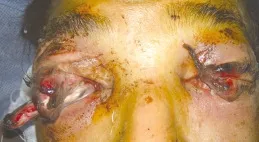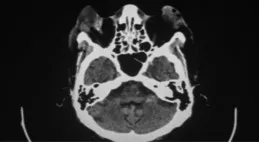Ocular mutilation: A case of bilateral self-evisceration in a patient with acute psychosis
Amar Pujari, Neelam Pushker, Milind Changole, Ritika Mukhija
Dr. Rajendra Prasad Centre for Ophthalmic Sciences, All India Institute of Medical Sciences, New Delhi, India
Ocular mutilation: A case of bilateral self-evisceration in a patient with acute psychosis
Amar Pujari, Neelam Pushker, Milind Changole, Ritika Mukhija
Dr. Rajendra Prasad Centre for Ophthalmic Sciences, All India Institute of Medical Sciences, New Delhi, India
Dear editor,
Self-inflicted eye injuries in psychotic patients are not uncommon, it has been well described in the literature, earlier report date back to the mid-19th century, but it was there in ancient time as well. In developing countries, because of poor health care system, it seems many cases go undiagnosed and unreported. The underlying cause for such severe selfmutilation is multifactorial, self-enucleation (Oedipism)was earlier related to inappropriate sexual behavior with the mother and consequent self-harm (Freud's famous Oedipus complex) or due to certain religious thoughts.Today with the growing literature on many aspects of human psychology, one of the major psychiatric illness such as schizophrenia, depression, obsessivecompulsive disorder or drug abuse is the predisposing factor but among this schizophrenia is the major illness in significant number of cases.[1–6]
CASE
A 42-year-old male patient was brought to eye emergency with a history of self-inflicted injuries in both the eyes. On examination, the patient had an altered sensorium with bleeding from both the orbits along with blood stains over both the periorbital region. Both eye upper and lower lid lacerations were noted, and in the right eye there was prolapsed scleral tissue without any visible cornea or intraocular contents, whereas in left eye the majority of the globe was eviscerated with only partial sclera and conjunctiva left (Figure 1).
The patient was continuously harming himself which lead to boggy swelling over his occipital region. The active bleeding from the ocular tissue was immediately stopped by direct pressure along with pressure dressing for both the orbits. A quick neurologic examination revealed a completely delirious state; initial orbital ultrasonography showed collapsed ocular coats without visible contents/foreign body, subsequent computed tomography of the head and orbit showed no visible globe in either of the orbits with soft tissue edema (Figure 2). There was no evidence of intracranial bleed or major organ damage and the patient was stabilized after evaluation by a psychiatry consultation.

Figure 1. Bilateral self-eviscerated globe with visible residual prolapsed sclera.

Figure 2. Noncontrast computed tomography showing empty orbit on both the side.

Figure 3. Clinical prof i le after placement of implant and repair of all the eyelid laceration.
The patient was operated for both eye upper and lower lid lacerations repair along with the placement of an orbital implant and conformer on day three to avoid infection of the exposed tissue and spread of the same to the intracranial structures (Figure 3). Subsequent history following stabilization revealed patient was experiencing auditory hallucination, since a year and a half, following familial problems, but never had any evaluations for the same. The patient stated hearing commands about his eyes being not worthy and should be punished by injuring them, so probably this would have decompensated on the idea of his wife being unfaithful to him is one of the reasons for self-evisceration which can be attributed to a schizophrenic condition. During subsequent follow-up patient and caretaker denied for any cosmetic surgery.
DISCUSSION
Self-evisceration is a very serious form of selfmutilation, ocular self-mutilation lie along a continuum,these can be analyzed as: (1) Periorbital injuries and injuries involving anterior and posterior segment structures.[1](2) Globe perforation with various sharp instruments during hallucinations.[2](3) Globe rupture with the removal of intraocular contents (selfevisceration).[3](4) Complete enucleation.[4–6]These are all forms of injury based on amount and extent of ocular tissue loss.
In our case, the extent of uveal tissue loss was almost complete in both the eyes with almost completely retained sclera in right while there was a partial remnant in the left eye. The ocular mutilations are very debilitating as vision is an utmost sensory function required for an individual. Because of external ocular injuries patients are brought to the ocular emergency, in such scenario, the ophthalmologist should be cautious in eliciting the probable nature, cause for the injury and under which circumstances it might have happened,which help in the further prevention of self-mutilating injuries and observed treatment under a psychiatrist.
The psychological basis for these acts in schizophrenic patients is due to structurally weaker inhibition/dysfunctional feedback mechanism which can be explained by Frith's efference copy, in which during high emotions efference copies to the cerebellum are thought to be less efficient or less functional along with inhibition of prefrontal cortex,leading to lack of inhibitory control and ocular mutilation.Similarly, Theory of mind (ToM) (Theory of mind is the ability to attributes mental states to self or others) skills in these individuals are normally developed but they are lost following initial psychotic episodes.[7,8]
CONCLUSION
In literature the enucleation constitutes a number of cases as compared to evisceration; the patient in the discussion has harmed his eyes for almost few hours to damage seriously. To avoid such kind of such selfmutilation it is important for both the psychiatry and ophthalmology personnel to be aware of their importance in avoiding such complications by prior awareness and guidance to caretakers. Visual, cosmetic and psychosocial rehabilitation is necessary when happened under such unavoidable circumstances.
Funding: None.
Ethical approval: Not needed.
Conflicts of interest: The authors declare that there are no conf l icts of interest relevant to the content of the article.
Contributors: Pujari A proposed the study and wrote the first draft. All authors read and approved the fi nal version of the paper.
1 Reichstein D, Esmaili N, Wells T, Kim JE. Attempted autoenucleation in two incarcerated young men with psychosis. Saudi J Ophthalmol Off J Saudi Ophthalmol Soc. 2015;29(2):172–4.
2 Amiri S, Arfaei A, Farhang S. Self-inf l icted needle injuries to the eye: a curing pain. Case Rep Psychiatry. 2015;2015:960579.
3 Eshraghy B, Abdi F, Faramarzi N, Esfahani M, Akbari Baghbani M. Auto-evisceration in an elderly schizophrenic female. Int Ophthalmol. 2013;33(6):717–20.
4 Koh KGWW, Lyeo BK. Self-enucleation in a young schizophrenic patient–a case report. Singapore Med J. 2002;43(3):159–60.
5 Davidson SI. Auto-enucleation of the eye: A study of selfmutilation. Acta Psychother Psychosom. 1962;10:286–300.
6 Clinebell K, Valpey R, Walker T, Gopalan P, Azzam P. Selfenucleation and severe ocular injury in the psychiatric setting.Psychosomatics. 2016;57(1):25–30.
7 Bazan A. From sensorimotor inhibition to freudian repression:insights from psychosis applied to neurosis. Front Psychol.2012;3:452.
8 Frith CD. The Cognitive Neuropsychology of Schizophrenia.Hove, UK: Lawrence Erlbaum Associates; 1992.
Accepted after revision April 30, 2017
Amar Pujari, Email: dramarpujari@gmail.com
World J Emerg Med 2017;8(3):233–234
10.5847/wjem.j.1920–8642.2017.03.013
December 29, 2016
 World journal of emergency medicine2017年3期
World journal of emergency medicine2017年3期
- World journal of emergency medicine的其它文章
- A case of exercise induced rhabdomyolysis from calf raises
- Instructions for Authors
- Iatrogenic Horner's syndrome: A cause for diagnostic confusion in the emergency department
- Blunt injury to the thyroid gland: A case of delayed surgical emergency
- Validation of different pediatric triage systems in the emergency department
- Association of post-traumatic stress disorder and work performance: A survey from an emergency medical service, Karachi, Pakistan
